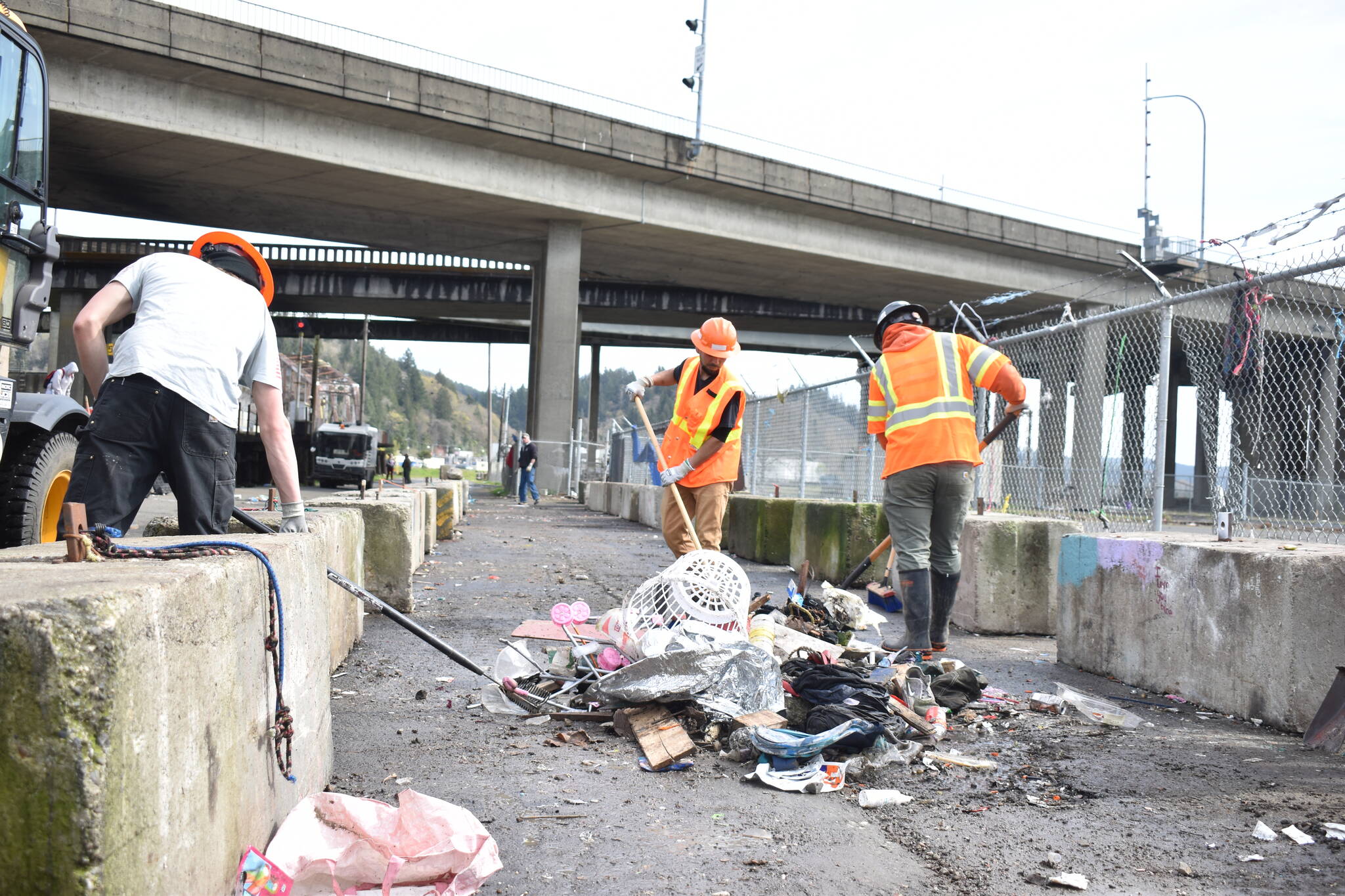Intensive cleanups at Aberdeen’s major homeless camps near the Chehalis River bridge will occur more frequently this spring and summer as the city looks to curb trash and waste accumulation.
During the cleanups, homeless residents at the River Street camp are given a chance to gather belongings and move them temporarily to a property on the opposite side of the railroad, while city workers use brooms and heavy machines to scoop remaining structures and debris into dump trucks. Homeless residents move back to the area abutting the chain link fence on River Street, either with new tents or to rebuild tarped structures, after street cleaners scrub the area.
That process occurred twice in 2023 but will now happen monthly.
Aberdeen Mayor Doug Orr said Wednesday the city believes that schedule will reduce buildup and save money spent on staff tending day-to-day trash pickups.
The city has spent a little more than $300,000 on downtown and homeless camp trash cleanups since it started tallying and reporting that data at the beginning of 2023. About $137,000 was spent during the first seven months of that period while $165,000 was spent during the latter seven months, with an overall average of about $21,500 per month.
Wednesday’s cleanup was the third since the city’s homeless response committee initiated the action in March 2023. That month the city spent an extra $10,000 on additional staff an equipment for the cleanup, which took an entire day. That wasn’t the case during another big cleanup in September, a month the city spent $20,000.
The city has billed the state transportation department for some cleanup services at the homeless camp on the agency’s property under the bridge.
Bill Sidor, the city’s code enforcement officer, said on Wednesday the cleanup was moving more efficiently than in the past, with the street sweeper taking to the camp before noon. He said he provided a notice of the cleanup two to three weeks in advance and a reminder on Monday.
Despite the chance to move existing tents and belongings from the encampment while the city moves in, the major cleanups often result in the destruction of makeshift shelters. Robert Anguish, who lives at the River Street camp, acknowledged the city’s effort to address the “garbage factor,” but said more frequent cleanups will make it harder for homeless people to shelter from inclement weather, even as it warms up.
“It’s a costly thing,” he said. “It doesn’t really do anything but drive the homeless person further down into the hole.”
Anguish returned to the River Street camp recently after receiving a temporary stay in a motel through a voucher system. A former Westport Shipyard worker, he said he became homeless after an injury and a relationship fallout.
He said the city should look to a more collaborative solution, and suggested he would be willing to work to clean up the downtown core, which he says would provide homeless people not only money but help restore pride.
Laina Caldwell, behavioral health navigator for the three central Grays Harbor police departments, has been working to implement something similar. Dovetailed with the heavy machinery cleanups is the launch of Caldwell’s “Good Neighbor Project,” a weekly outreach effort to encourage homeless residents to keep encampments tidier, while social service groups provide information about resources.
According to survey results conducted by the city of Aberdeen last year, trash was the number one concern voiced by residents in relation to the homelessness problem.
Ideally, a cleaner encampment would also make tents last longer, Caldwell said.
“We’re not going to be able to afford providing a new tent once a month,” Caldwell said Wednesday as she gave out food and supplies during the cleanup. “It’s just not gonna happen.”
Caldwell said she personally purchased 30 tents in preparation for Wednesday’s cleanup, while the Coastal Community Action Program bought 50 more. In past cleanups the city has provided insulated tents, but those resources have expired.
Social service groups met last week with the city to strategize about how to support people at the homeless camp during the cleanups and deliver resources, like tents, more effectively, said Joey Bannish, co-director of Destination, Hope and Recovery.
Gnat Why, who lives at the River Street camp, said she plans to rebuild her structure after moving pallets, tarps and building materials across the train tracks shortly before the city began cleanup Wednesday.
“To the naked eye, it’s dirty,” Why said. “But imagine us having to live in these conditions that are basically inhumane. That’s not acceptable for us to live like that. We have our own choices, but I think the city can definitely make some steps.”
Why said the dirtiness of the camp is partially due to lack of sanitation services, like a portable bathroom or running water.
“We want some more representation at city council, so we can bridge the gap between us and the community,” she said. “We don’t want this distance anymore. It’s hurting everybody in this town.”
Contact reporter Clayton Franke at 406-552-3917 or clayton.franke@thedailyworld.com.


